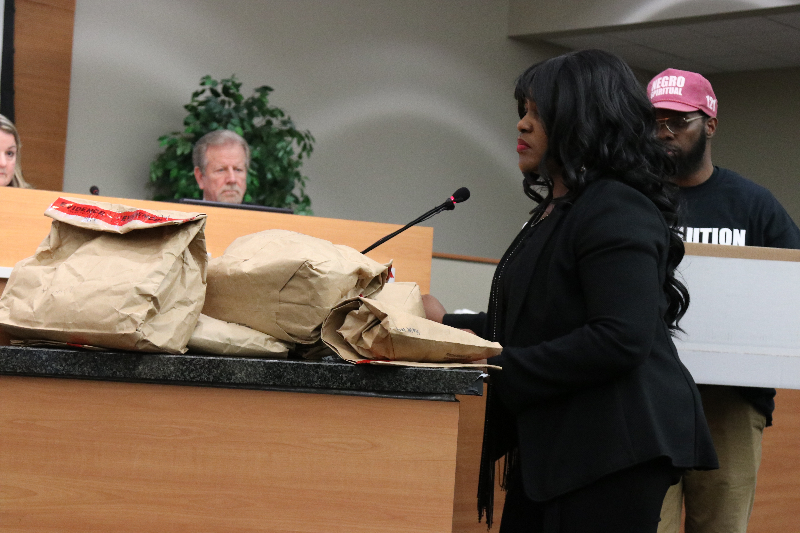
By Louis Gray
Eagle Staff Writer
Once upon a time, the Greenwood District of Tulsa was the hub of black commerce throughout the United States. It was famous for its cultural and financial achievements, rivaling New York City as a national center of urban black life. On May 31, 1921 and in the next two days following, it was destroyed by a well-armed white mob, some of them deputized by the police department. Then, it was the only American city bombed from the air.
Thirty-six square blocks were, razed. More than 3,000 homes burned to the ground. As many as 300 people were killed, many of whom were buried in mass graves or simply dumped anonymously into the Arkansas River. In all, 191 businesses, a junior high school, several churches, and the only hospital in the area were destroyed. The Red Cross reported that 1,250 homes were burned and another 215 looted. Of the 15,000 people living in the Greenwood District, 10,000 were made homeless after the killing and rage ended. Over the next year, local citizens filed more than US $25 million in claims in today’s dollars. A former Mayor, Judge Loyal J. Martin, the chair of the emergency committee, declared:
“Tulsa can only redeem herself from the countrywide shame and humiliation into which she is today plunged by complete restitution and rehabilitation of the destroyed black belt. The rest of the United States must know that the real citizenship of Tulsa weeps at this unspeakable crime and will make good the damage, so far as it can be done, to the last penny.”
In the end, not a single penny was paid to those who suffered the losses because the insurance companies, adopted in court the more palpable view that the mayhem was a “riot”, an event specifically excluded from its insurance policies and their view prevailed in the courts.
Fortunately, although hundred years late, the 1921 terrorist attacks are now characterized for what they were- “a massacre”. Notwithstanding, the people of Greenwood rebuilt and restored their economy.
But the real story of Greenwood cannot be told without telling the history of the Indian Renewal Act and the Indian Allotment Act. The history involving those U. S. government Acts and the relocation of both Indians and slaves to Oklahoma territory must be included. To understand Greenwood and how it became an economic dynamo is to look back before statehood.
Tulsa geographically is divided by three Native American Nations: the Cherokees to the east, the Osages to the North and west, the Muscogee Creek Nation on Greenwood and south. The old Tulsa Country Club in Gilcrease Hills sits at the intersection of all three tribes. Not only was Greenwood the original home of the Creek Nation, it was the original allotments of Creek Freedmen. With the advent of oil and gas exploration, many residents were reaping unheard of income from royalties. Much of that income helped fund education, startup businesses and created a level of economic independence. At one time, Black Americans owned over two million acres of land in Oklahoma. Many spent their money in Tulsa because segregation would not permit them to spend it elsewhere except in places other black Americans lived. But the circumstances which gave rise to that prosperity in the Greenwood District in 1921 and the forty years that followed no longer exists but the possibilities for economic prosperity for African Americans and others abound.
In its own way, Tulsa has tried to reconcile its dark history through small gestures of generosity and remembrance but there is a chance to do something that will be meaningful and long lasting. In Oklahoma City, the bombing of the Murrah Building is remembered with an interactive museum. The Little Big Horn Memorial, Red Earth Art Center in Oklahoma City, the National Underground Railroad Freedom Center and the Center for Civil and Human Rights all have museum and interactive exhibits remembering tragic yet important times in history.
All the aforementioned tourist sites average over 300,000 visitors a year. They either are national parks or created by local partners assisted by endowments to operate. The tourists for this type of exhibits are high-income tourists and often stay for several days. The Race Massacre Center would not only tell the story; it would stand as a crucible for conciliation. An endearing site for positive change and reflection are just part of what could be in Tulsa.
There are still places in the Greenwood district to create the center. One might imagine an interactive area that lets the visitor walk through a bustling Greenwood full of the sights and sounds of 1921. Perhaps another area that reveals what it was like during the savage hours complete with the sounds of bombs dropped from planes. Walking tours would also include all the other important historic sites in the area.
In short, Greenwood can be a destination site for people to visit, learn history and witness the celebration of human diversity. As a world class tourist attraction, it will create jobs while being self-sustaining and a spectacular place for the world to see.










